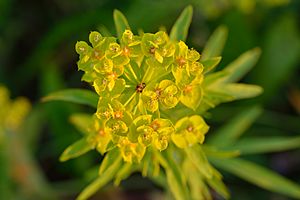Green spurge facts for kids
Quick facts for kids Green spurge |
|
|---|---|
 |
|
| Scientific classification | |
| Genus: |
Euphorbia
|
| Species: |
esula
|
Euphorbia esula, also known as green spurge or leafy spurge, is a type of plant. It grows naturally in central and southern Europe, reaching as far north as England, the Netherlands, and Germany. You can also find it across much of Asia, north of the Himalaya mountains, all the way to Korea and eastern Siberia.
Contents
What is Leafy Spurge?
Leafy spurge is a herbaceous perennial plant. This means it's a plant that doesn't have a woody stem above ground and lives for more than two years. It can grow quite tall, reaching about 1 to 1.2 meters (around 3 to 4 feet).
It has several stems that branch out from its base. These stems are usually smooth and don't have hairs. The leaves are small and shaped like a spear, about 4 to 8.5 centimeters long and up to 1 centimeter wide. Their edges are a little wavy.
The plant's flowers are tiny. They grow in clusters called umbels, which look like umbrella shapes. At the base of these flower clusters are bright yellow-green, petal-like parts called bracts. These colorful bracts appear in late spring. The actual small flowers don't show up until early summer.
Be careful! All parts of the leafy spurge plant contain a white, milky sap. This sap is toxic, meaning it can be harmful.
How Leafy Spurge Spreads
Leafy spurge can spread very easily. One way it spreads is through its seeds. These seeds have a high germination rate, which means many of them will sprout into new plants. They can also stay alive in the soil for at least eight years.
The seed capsules of leafy spurge open with a small explosion. This can shoot seeds up to 5 meters (about 16 feet) away from the parent plant! Water and wildlife can also carry the seeds even further.
The plant also spreads underground using its root system. This root system is very complex. It can reach up to 8 meters (about 26 feet) deep into the ground and spread 5 meters (about 16 feet) wide. These roots have many buds that can grow into new plants.
Different Kinds of Leafy Spurge
There are different types of Euphorbia esula, including two main subspecies and a hybrid subspecies (a mix of the two).
- Euphorbia esula subsp. esula: This type has leaves that are widest near the top. Its umbel bracts (the colorful parts near the flowers) are 5–15 millimeters long. You can find this subspecies throughout the plant's natural range.
- Euphorbia esula subsp. tommasiniana: This type has leaves that are widest in the middle. Its umbel bracts are longer, 12–35 millimeters. It is found in Eastern Europe and western Asia.
- Euphorbia esula nothosubsp. pseudovirgata: This is a hybrid, meaning it's a mix of the two subspecies mentioned above.
Not to Be Confused With!
Euphorbia esula is often confused with another plant called Euphorbia virgata. For a long time, people thought E. esula was growing in North America. However, scientists now believe that the plant causing problems in North America is actually E. virgata.
E. esula is not considered a problem plant in Europe. But E. virgata is found all over the United States and Canada. It has caused big economic and environmental issues there.
You can tell E. virgata apart from E. esula by looking closely at their leaves.
- E. virgata leaves are usually 6 to 15 times longer than they are wide. Their edges are almost parallel in the middle.
- E. esula leaves are wider near the tip and are usually only 3 to 8 times longer than wide. Their edges are not parallel in the middle.
Also, the tip of E. virgata leaves is usually pointed. The base of its leaves can be flat or narrow. For E. esula, the tip of the leaves is usually rounded or slightly pointed, and the base narrows more gradually. So, if you read about E. esula in North American books about plants or invasive species, it's probably talking about E. virgata instead!
See also
 In Spanish: Euphorbia esula para niños
In Spanish: Euphorbia esula para niños


